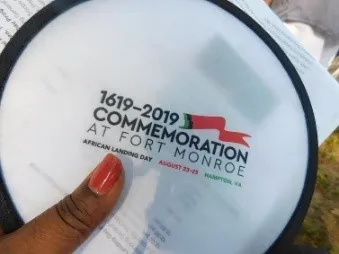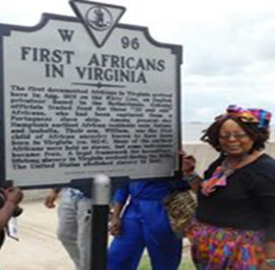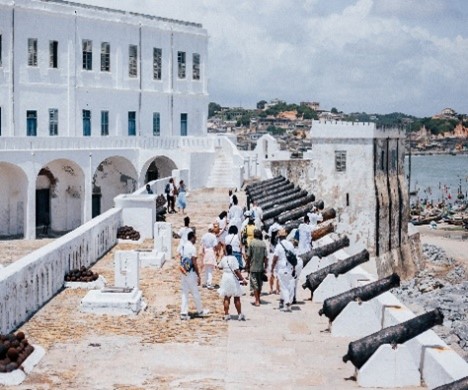My Sankofa Experiences, Part 2
Last month I shared what I called a “Sankofa” experience that helped me to find out more about myself. Sankofa is a word from West Africa that means: “one must look back so they can move forward. My very first trip to Africa proved insightful as it took me back to a place I’d never been, but helped me find out more about who I am. Part two of this blog shares more of my Sankofa experiences.
My next experience began in 2019 in an area near my home. It focused on offering historical accuracy of an event and its place in Virginia history. For many generations, people were taught that the Mayflower was the first ship that arrived in the Americas in 1620, carrying enslaved people along with others. More recent evidence confirms that in 1619 the first 20 enslaved Africans arrived at Fort Monroe, previously, a military fort called Port Comfort. These enslaved people were part of the “Tucker Family” and as a result, the institution of slavery began in Virginia.
In 2019, thousands of people experienced “The Commemorative African Landing Day”, a 400th recognition of the first Africans’ arrival in the United States. There was a weekend of reflection, healing, and honoring the first enslaved people on these shores. Well-known speakers, such as CNN’s anchor Van Jones, Norfolk State University Professor Dr. Cassandra Newby Alexander, Lieutenant/Governor Justin Fairfax, and other leaders spoke. There were a variety of conversations, presentations, poetry, music, and dancers along with a healing bell-ringing ceremony, which was all a part of this amazing weekend. As I looked out at the Chesapeake Bay, near the First Africans in Virginia mile marker, I tried to imagine what things were like during their arrival. We looked back to the year 1619 for answers and began to move forward in 2019.

(photo, left, Commemorative Fan for the Fort Monroe African Landing Day in 2019)
During this event, there were discussions on ways to move forward, such as dialogues with people of other races to educate people on the effects of slavery, and identified various issues that existed to reduce and demean blacks in the past and what to do with the historical
knowledge that has been gained. Virginia’s Governor Northam recommended it was important to share knowledge with young people about slavery and the past. Approved plans for slavery and its effects were recommended to be embedded in the school curriculum throughout the state. The status, however, is pending concerning this recommendation. Our reflections at the momentous event offered concrete goals that could help African Americans move forward in their Sankofa experience.

(photo, left, Mile Marker at Fort Monroe)
My final and more recent Sankofa experience occurred when I was able to visit Ghana West Africa, where some of the very first Africans were captured, and shipped as enslaved people to the United States. I visited what was called “slave castles”, which were actually dungeons that more accurately described these buildings. These dungeons were built initially by the Portuguese, who seized and colonized the country of Ghana along with the creation of slave dungeons with cannons, forts, and weaponry. This was to discourage other groups from coming to Ghana to control the very same country that was already colonized by them. The Portuguese housed Africans in these castles/dungeons in cramped, deplorable, inhumane conditions such as no sewage disposal while waiting for ships to arrive to transport Africans to the Americas to become enslaved. Our guide described the horrid conditions that enslaved people endured while waiting for the slave ships to arrive: waiting without food or water, along with being separated from their tribe, family, and culture before being chained and shackled onto ships to the New World.
I again looked at the beautiful shoreline and breathtaking views as I looked toward the ocean but was reminded that the horrid trips began in Ghana. Upon their arrival in Virginia, this system began and continued with the institution of slavery that remained in place for 400 years. I was in a strange juxtaposition appreciating the beauty of this Ghana land but knowing the horror that was experienced here. I wept, I ached, I mourned. Deeper connections about myself helped to aid, and soothe while healing the anger and gut-wrenching pain of a terrible past.
A sad and painful past that still haunts African Americans in the realm of “generational trauma”. This type of trauma is a byproduct of the effects of slavery that still impacts generations of Blacks today in a variety of ways through lack of self-esteem, fewer educational opportunities in the workplace, the judicial system, and other areas of everyday life. I was comforted knowing that another percentage of my DNA also matched my Ghanaian roots. Going back helped me to determine how to move forward.

(the author visiting the slave /dungeons in Ghana, West Africa)
Next month will be the final blog in the series and will share lessons learned about all of my Sankofa experiences.
~ Rochelle Pleasant, M.A.E.D.
Rochelle is an early childhood educator. She has been a teacher, mentor, and coach, and provided training to many early childhood educators nationally and in the Republic of Azerbaijan, and Kenya West Africa. She has offered a variety of workshops, particularly, focusing on culture and diversity, with a previous role that helped to create a diversity task force team with a former organization. This is part two of a three-part blog that relates to the importance of culture.
